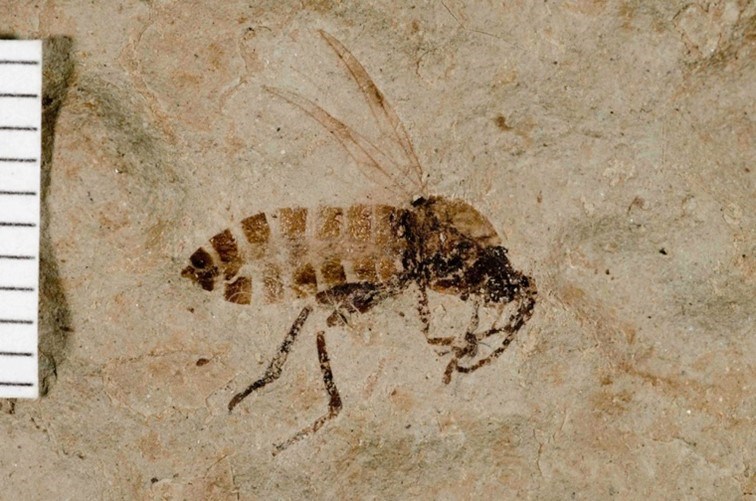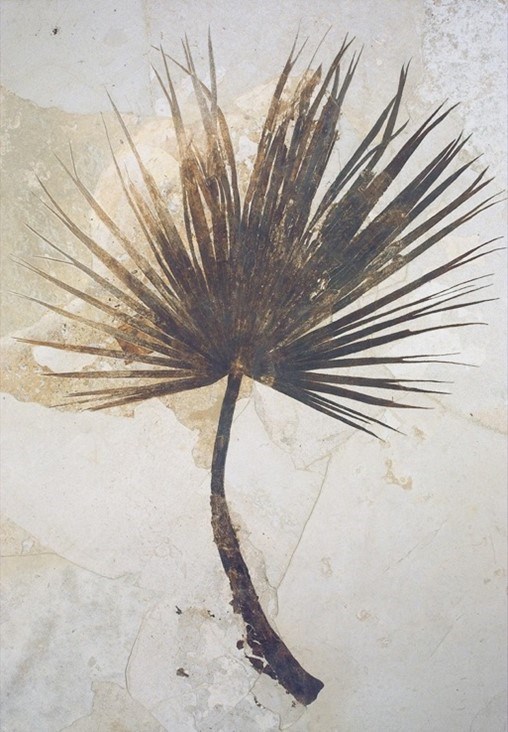Last updated: May 31, 2024
Article
Impressions and Compressions (including Carbonization)

NPS photo.
Introduction
The formation of impressions and compressions are important ways that living things become fossilized. Many especially significant fossils from national park sites, particularly Fossil Butte National Monument and Florissant Fossil Beds National Monument, are either impressions or compressions, some showing exquisite fine details of fossil fish, birds, leaves, flowers, and insects.
Impression Fossil

NPS photo.
Compression Fossil

NPS photo.
Combination Impression and Compression
Some fossils, like many of the insect fossils at Florissant Fossil Beds National Monument, are both compressions and impressions. The body of the insect may leave a carbon film but there may be only an imprint of the wings.

NPS photo.
Compression fossils that retain carbon films become generally more rare in older rocks as a carbon film is not as stable as lithified rocks. Some Mesozoic and Paleozoic fossil leaf impressions may be all that is left after carbonized material disintegrated.
Carbonization occurs because when organic matter decomposes, it releases gases and fluids, leaving a residue of carbon compounds behind. The material that remains is a black or brown film that shows the exact shape of the organism, often including soft tissues. Carbonization is particularly effective in preserving leaves, but delicate animals such as fish and insects are also preserved in this manner.
Learn More
Coal is formed by the compression and chemical alteration of plant remains. Plant fossils are present in many coal beds. National park areas that have coal beds include Big South Fork National River and Recreation Area, Cumberland Gap National Historical Park, Flight 93 National Memorial, and New River Gorge National Park and Preserve.Many impression fossils never included carbonized remains, but represent only the imprint of the organism, or a part of one, like a fossil leaf.
Impression and compression fossils may be of hard or soft parts of organizations, or both, as in the fossil fish of Fossil Butte National Monument.
Impressions may be a part of fossil tracks or traces. For example, dinosaur skin imprints are known from dinosaur tracks in Curecanti National Recreation Area.

Lockley et al., 2008.
Occurrence
Fossil impressions and compressions usually occur in very-fine-grained sediment where organisms or organic material like leaves, feathers, or skin were buried before decay could take place. Sediments with small grain sizes have a greater ability to preserve details than larger sizes. Additionally these sediments are less porous and permeable, which also slows decomposition, and are typically deposited in areas with low currents and few burrowing animals, also making it more likely that fossils are preserved.
Typical depositional environments where fossil impressions and compressions may be preserved include lakes, floodplains, and swamps, as well as volcanic areas where volcanic mud flows or ash beds buried and preserved plants and animals.
Any type of organism may be preserved as a fossil impression or compression, but these kinds of preservation are a particularly important way that plants or animals that lack hard parts are fossilized. Additionally, impressions and compression fossils are typically the only record of soft parts such as skin, scales, feathers, and organs of vertebrate animals, as well as leaves and flowers of plants.
National Park Examples
Colorado National Monument
Colorado National Monument has an incredibly rich fossil record that includes an impression of dinosaur skin. This specimen is from the Naturita (Dakota) Formation, which is an Early Cretaceous transgressive unit found in western Colorado and eastern Utah. The Naturita Formation itself is very fossiliferous and is best known for dinosaur trackways.

Dinosaur skin impression, Colorado National Monument, Colorado.
Austin Shaffer, Austin Shaffer, 2023–2024 Paleontology Intern, Colorado National Monument.
Florissant Fossil Beds National Monument
The fine shales of the Florissant Formation contain a large number of compression and impression fossils of insects, flowers, leaves, and other types of biological remains that are rarely preserved as fossils. More than 1,850 fossil species have been described from the formation, many from the monument, including many type specimens (holotypes) and some fossils that have not documented elsewhere.
The Florissant Formation was deposited in a lake that formed when a river drainage was dammed by a volcanic mudflow (lahar) after eruption of the nearby Guffey volcanic complex about 35 to 34 million years ago, during the Eocene.
The compression and impression fossils in the Florissant Formation are in thin “paper shale” layers a millimeter or less thick. These consist of a couplet of layers –a layer rich in diatoms (a type of microscopic algae with cell walls of silica) over a layer of volcanic ash/clay. Diatoms bloomed as a response to silica-rich ash being washed into the lake. After they died off, they fell to the bottom of the lake and protected organisms and organic material from decay, ultimately leading to fossilization.

Unidentified flower compression. Florissant Fossil Beds National Monument, Colorado.
NPS photo.
Fossil Butte National Monument
The many compression and impression fossils in Fossil Butte National Monument are found in deposits from a large shallow freshwater lake that existed in southwestern Wyoming during the Eocene, approximately 52 million years ago. The fossils are found in laminated calcite-rich mudstone of the Fossil Butte Member of the Green River Formation.
Fossil preservation in Fossil Butte National Monument was aided by a layer of oxygen-poor saline water and a microbial mat that were present at the bottom of the lake. The layer of salt water kept scavengers away and the microbial mat encased dead organisms and kept them from breaking apart.

Twenty-six species of fish have been reported from Fossil Butte National Monument and Fossil Lake, Wyoming. This specimen is Diplomystus dentatus, a primitive fresh water herring, and is the second most common type of fossil fish found in the monument.
NPS photo.
John Day Fossil Beds National Monument
The Clarno Nut Beds in John Day Fossil Beds contain a wealth of fossils including compressions or impressions of many different types of leaves, other plant material, and insects. It also contains permineralized fossils such as petrified wood, seeds, and nuts. The Clarno Nut Beds are a sequence of tuffaceous siltstones, sandstones, and conglomerates that were deposited in a lake delta environment in a subtropical climate about 44 million years ago.

A compression of a sycamore leaf, Clarno Nut Beds. John Day Fossil Beds National Monument, Oregon.
NPS photo.
Yellowstone National Park
Impressions of fossil leaves occur in Eocene age occur along with petrified woodin Yellowstone National Park. These fossils were preserved in volcanic mudflows known as lahars.

Fossil leaf impression. Yellowstone National Park, Montana.
NPS photo by Justin Tweet.
Featured Parks
-
Big South Fork National River and Recreation Area (BISO), Kentucky and Tennessee—[BISO Geodiversity Atlas] [BISO Park Home] [BISO npshistory.com]
-
Colorado National Monument (COLM), Colorado—[COLM Geodiversity Atlas] [COLM Park Home] [COLM npshistory.com]
-
Cumberland Gap National Historical Park (CUGA), Kentucky, Tennessee, and Virginia—[CUGA Geodiversity Atlas] [CUGA Park Home] [CUGA npshistory.com]
-
Curecanti National Recreation Area (CURE), Colorado—[CURE Geodiversity Atlas] [CURE Park Home] [CURE npshistory.com]
-
Flight 93 National Memorial (FLNI), Pennsylvania—[FLNI Park Home]
-
Florissant Fossil Beds National Monument (FLFO), Colorado—[FLFO Geodiversity Atlas] [FLFO Park Home] [FLFO npshistory.com]
-
Fossil Butte National Monument (FOBU), Wyoming—[FOBU Geodiversity Atlas] [FOBU Park Home] [FOBU npshistory.com]
-
John Day Fossil Beds National Monument (JODA), Oregon—[JODA Geodiversity Atlas] [JODA Park Home] [JODA Npshistory.com]
-
Mammoth Cave National Park (MACA), Kentucky—[MACA Geodiversity Atlas] [MACA Park Home] [MACA npshistory.com]
-
New River Gorge National River (NERI), West Virginia—[NERI Geodiversity Atlas] [NERI Park Home] [NERI npshistory.com]
-
Yellowstone National Park (YELL), Idaho, Montana, and Wyoming—[YELL Geodiversity Atlas] [YELL Park Home] [YELL npshistory.com]
